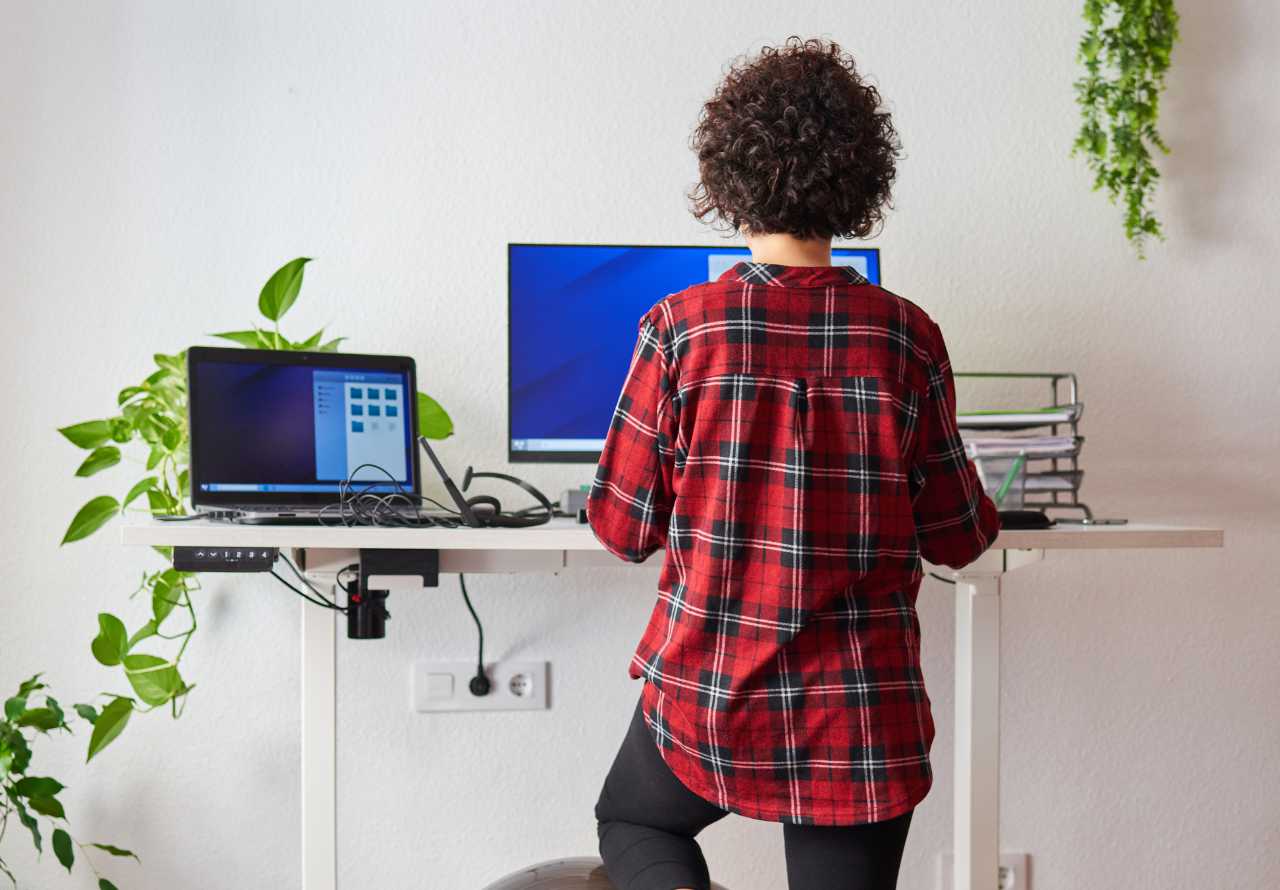
Loved by some and dismissed as a passing trend by others, sit-stand desks are becoming familiar sights in offices. While some people are still sceptical about their use, there are plenty of benefits of sit-stand desks to be gained by transitioning employees from a traditional workstation to using an ergonomic sit-stand desk and workstation.
According to Posture Group, a UK adult will spend more than seven hours sitting each day, with a potential increase of up to ten hours per day as people age. Whether in the car, at work, or at the dinner table, sitting for prolonged periods can lead to physical harm. With an estimated 29.5 million people working in the UK, a sizeable portion of those employees will be office-based and sitting. The benefits of sit-stand desks can help improve the well-being of some of those office-based employees, both mentally and physically.
What is a sit-stand desk?
A sit-stand desk is a height-adjustable desk used to either work from a sedentary position or standing up. These desks are designed to support employees who may want to move around during the working day but can still work and stand at the same time.
Organisations should have appropriate DSE (Display Screen Equipment) measures to ensure that there is no risk to workers’ health and safety. Providing sit-stand desks may help support compliance and legal workstation obligations while addressing any potential health issues your employees may have.
All employees who regularly use display screen equipment as part of their duties must undergo DSE training. Our Display Screen Equipment (DSE) Training Course at Praxis42 helps ensure employees can work safely with display screen equipment, identify risks and know how to avoid problems by using simple ergonomic principles.
What are the benefits of sit-stand desks?
Transitioning to a standing desk should be done gradually as it may initially put additional strain on the joints and muscles. However, there are several benefits of sit-stand desks.
Reducing back pain
Lower back pain is probably one of the most common issues affecting sedentary employees. Several studies have been conducted on sit-stand desks and whether their use could offer a solution.
New data from Google Trends shows that there’s been a 34% increase in UK Google searches for ‘standing desks’ in the months following the Covid-19 pandemic. Companies Digest also reported:
- A 78% increase in searches for local chiropractors.
- A 7% increase in searches related to neck aches.
- Searches about neck and shoulder pain increased by 5%.
Whilst a sit-stand desk won’t make your back pain disappear, it could go a long way to alleviating the stress on your back and other joints when sitting.
Boosting energy and productivity
Spending extended periods sitting down can often lead to a drop in energy levels, with most office workers feeling sluggish by the afternoon. By switching to a sit-stand desk, users can change position when they begin to feel like their energy levels are dropping, as standing up naturally offers a boost of energy.
Alternating between sitting and standing throughout the day also positively affects circulation. By promoting good circulation, using a standing desk can also improve productivity and concentration, resulting from improved blood flow and static tension in muscles and connective tissues, increasing the risk of musculoskeletal disorders (MSDs).
Improving posture
Using a sit-stand desk can also benefit employees by helping them improve their posture when used correctly. A standing workstation will let employees carry out their work without hunching over, slouching, or adopting a poor posture. By alternating between sitting and standing, users who have been adequately trained can always assume the correct posture, switching positions to maintain comfort.
Lowering blood sugar levels
Although it is normal for blood sugar levels to fluctuate during the day, they can lead to a general sense of poor wellbeing and even more serious issues if not kept in check. Thankfully, using a sit-stand desk can help offset such spikes in blood sugar. A Clearvue Health study found a 43% decrease in blood glucose fluctuations for standing vs sitting, limiting the spikes in blood sugar that can happen if you stay seated.
Where can I find out more about the benefits of sit-stand desks?
At Praxis42, we provide an in-depth Display Screen Equipment training course that will cover the benefits of sit-stand desks, as well as vital additional measures your organisation can implement to improve your employee’s health whilst working. Our training course is IOSH approved, and CPD certified.
Contact us today to find out more about sit-stand desks and how to use them correctly.
Our Display Screen Equipment training course adheres to IOSH approval requirements, CPD certification standards and is SCORM compliant. Our training is designed to help organisations comply with the Health and Safety (Display Screen Regulations) 1992.

Adam Clarke
Managing Director (Consulting)
